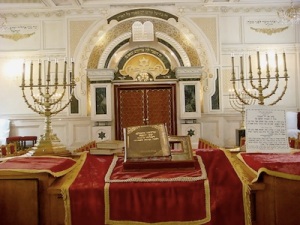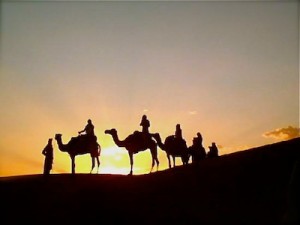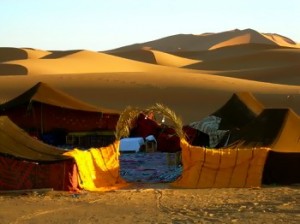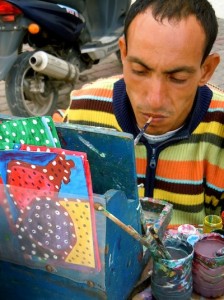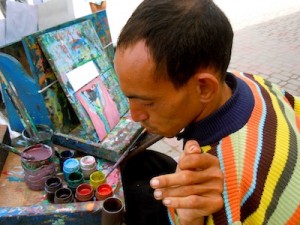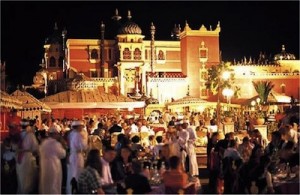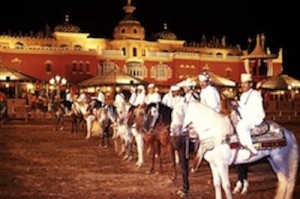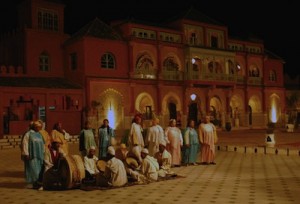
Majorelle Gardens, Marrakech
Discover the tradition and history of Moroccan Gardens on this nationally guided tour written by horticultural and garden enthusiasts for gardeners. Journey through the Morocco’s most private and public green spaces and places. Great pleasure of the senses will be experienced on this exotic 10-Day tour that includes Morocco’s Imperial Cities and rural regions with a 4-Day extension option to the Gardens of Tarodaunt and the High Atlas Mountain green spaces of Imouzzer des Ida Outanane. The Gardens of Morocco Tour is an ideal way to connect with fellow gardeners from around the world. Discover ancient cities led by licensed historical guides and their gardens with expert Gardeners, Botanists, Nurserymen and Herbalists.
MAJESTIC GARDENS OF MOROCCO 10-DAY TOUR
Group Tours Available in Spring & Fall 2012:
April 1st – 10th, 2012
May 8th – 17th, 2012
September 8th – 17th, 2012

Jnan Sbil Gardens and Fountain Fes
GARDENS & PUBLIC GREEN SPACES VISITED ON THE TOUR
Andalusian Gardens at Kasbah Oudaia & Exotic Gardens at Sidi Bouknadal in Rabat region
Roman Ruins Garden at Volubilis
Sultan Gardens at Jnane Sbil & Batha Garden – Museum in Fes
Moorish and Art Deco Gardens at Majorelle in Marrakech
Propagator Specialist & Native – Drought Tolerant Nurseries in Marrakech
Historical Landmark Garden at La Mamounia in Marrakech
Oasis Gardens at the Palmerie in Marrakech
Harti Gardens & Cyber Park in Marrakech
Marrakech Private Villa Garden
Saffron Gardens in the Ourika Valley
Herbal & Medicinal Gardens at Nectarome in the Ourika Valley
Gardens at La Roserie in the Ouirgane region
Guest Rates:
$5,075 – 4PAX (Shared Double)
$4,600 – 6PAX (Shared Double)
$4,250 – 8PAX (Shared Double)
$3,995 – 10PAX (Shared Double)
Single Supplement Rate: $1,350
Rates Include:
Luxury Transport
5 Star Accommodations
Licensed Historical Guided Tours in the Imperial Cities
8 Guided Garden Tours by a Botanist, Nurserymen and Herbalist, Garden & Monument Entrances Fees
14 Meals (Breakfast Daily at your Riad or Hotel, Welcome Dinner, Lunch at a Palace Style Riad in Fes and Farewell Dinner)

Kasbah Oudia Garden, Rabat
DAY 1: CASABLANCA – RABAT (Driving Time: 1 ½ Hours)
►Arrival in Casablanca.
►Visit the Mosque of Hassan II. Casablanca is home to the Hassan II Mosque, designed by the French architect Michel Pinseau. It is situated on a promontory looking out to the Atlantic, which can be seen through a gigantic glass floor with room for 25,000 worshippers.Its minaret is the world’s tallest at 210 meters. It is an enormous architectural masterpiece and the second largest religious building in the world. On Fridays, the Mosque of Hassan II is open to non-Muslims.The Mosque of Hassan II’s promontory offers lovely views overlooking Casa in the residential Afna quarter.
Visit Kasbah Oudaia & Andalusian Gardens:
►Tea and Pastries at Café Maure set on the grounds of the Kasbah Oudaia.
►Its location on a rocky outcrop high above the level of the river is an imposing site especially for the pirates of days gone by. When you enter the grounds of Oudaia you immediately notice the Andalusian influence. Everything here reminds one of Spain, walls uniformly covered with lime, blue everywhere, the cobbled streets, the massive doors to colored moldings and wrought iron. The formal structured Andalusian style gardens are bordered with red hibiscus, hedges, morning glories, brugmansias, date palms and orange trees with a long harbored walkway covered in grape vines.
►The Kasbah Oudaia is a beautiful and quiet residential area with its white and blue painted houses decorated with flowers. Kasbah Oudaia has become a haven for artists, attracted by the beauty of the site as much as by its soothing tranquility.
►Lunch by the sea at Borj Eddar in Rabat.

Polynesian Garden, Sidi Bouknadal, Rabat Region
Visit Sidi Bouknadal Exotic Gardens
►In 1951, Marcel François, a French horticultural engineer acquired 4 acres of flat and exposed land in Sale, Morocco. Ten years later he opened to the public his childhood dream, Bouknadel Exotic Gardens, a horticultural and artistic achievement, listed among the wonders of nature and now classified as a national cultural heritage site since 2003.
►The gardens are a composition of exuberant creativity and technical ability. Francois, traveled all over the world collecting plants as far away as China, South Asia, the Savannah, Congo, Japan, Brazil and Polynesia. He then set about duplicating these gardens at Sidi Bouknadal by incorporating landscape, habitat and climate in his plant compositions.
►The gardens are divided into three areas: a reception area, horticultural production area and finally, by far the most impressive, the garden area. All through the garden there are secret passages, an aviary, waterfalls, swamps, pools, fountains, bridges and walkways to lead you through the various gardens.
►Welcome Dinner at a Sofitel Le Jardin Des Roses.
►Spend the night at Sofitel Le Jardin Des Roses in Rabat.
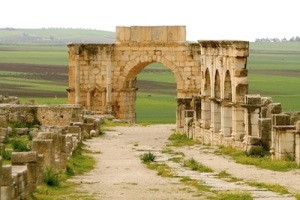
Volubilis Roman Ruin Gardens
DAY 2: RABAT – MEKNES – VOLUBILIS (Driving Time: 3 Hours)
►Breakfast at your Hotel then take the road to Fes. En route to Fes visit the Imperial City of Meknes & the Roman Ruins and Gardens of Volubilis.
►Arrive in Meknes and begin your tour of Meknes at Bab Mansour. First we will pass through the triumphal arch. Standing at sixteen meters high with an eight meter long arch, the intricately patterned triumphal arch is argued to be the most beautiful in Morocco. Enter Place El-Hedime (Square of Ruins) which links the medina and the kasbah. The square is lined with modern residential buildings and a covered food souk (market).
►We will stop and visit the Musée Dar Jamaï, a museum showing modern Moroccan arts, woodwork, ceramics, carpets, costumes, jewelry and metalwork. The sophisticated building was once a palace incorporating a mosque, menzah (pavilion), courtyard, kitchen and hammam.
►Visit the Moulay Ismail Mausoleum and the former gardens of the Royal Palace.
►Among the most impressive elements of this imperial city is the grand gate named after the architect, El-Mansour, a Christian renegade who converted to Islam. The design of the gate plays with Almohad patterns. It has zellij mosaics of excellent quality. The marble columns were taken from the Roman ruins of Volubilis.
►Visit the Olive market which sprawls throughout the old souk and the main square.
►Lunch in Meknes at a restaurant in the old French city with excellent Moroccan cuisine and a variety of local wines produced within the region.
►Arrive in Volubilis for a visit. Once occupied by the Romans, Volubilis has been recognized by UNESCO as a World Heritage Site and gained international acclaim when Martin Scorsese made it a feature location for his film, The Last Temptation of Christ.
►Begin your visit by discovering the fascinating Roman ruins adorned with beautiful mosaics and colorful tiles depicting Roman mythology. The ruins are spread out across several green acres. The ruins reveal how the Roman Empire transformed the original Carthaginian settlement into a typical Roman city complete with mansions, a town center, a triumphal arc and temples devoted to the Roman gods.
►Enjoy tea at the small café that sits just below the Volubilis ruins before taking the road to Fes.
►Dinner in Fes at your Riad or Hotel in Fes.
►Spend the night at a Moroccan traditional Riad or Hotel in Fes.

Andalusian Style Garden, Batha Museum Fes
DAY 3: FES – JNANE SBIL GARDENS & BATHA MUSEUM & ANDALUSIAN GARDEN
►Breakfast at your Riad or Hotel in Fes.
Visit Jnane Sbil Gardens:
►Jnane Sbil Gardens were originally created by the Sultan Moulay Abdallah. Jnane Sbil encompasses 7.5 hectares and is located in the heart of city. It is one of the oldest gardens in Fes. Because of its historical importance, great care was taken to restore the garden to its original design and after four years of detailed restoration and renovation of the heirloom plants, the hydraulic systems and the famous waterwheel, the project was completed and re-opened in June 2010.
Batha Museum & Andalusian Garden
►Next visit the Batha Museum & Andalusian Gardens. The Musee Dar el-Batha offers up a great collection of pottery, leatherwork, wood, books and manuscripts from the nineteenth century centered around a green spacious courtyard. The Batha Andalusian Garden boasts a three-hundred year old Quercus Rotundifolia, Washington Fifera, Cycas Revolta and Moroccan fountains.
►The Batha Garden is a serene escape from the bustling medina in Fes. It is also utilized each June by the Fes Festival of Sacred World Music whereby various world music groups perform.
►Visit Palais Jamai Hotel which boasts the oldest example of Andalusian style gardens in Al Hambra Classical Axial lines.
►Lunch at Palais Dar Tazi, a traditional palace-style Riad.
►Relax at your Riad or Hotel. Shopping excursion option in the old city.
►Dinner at your Riad or Hotel or traditional Moroccan restaurant.
►Spend the night at a Moroccan traditional Riad or Hotel in Fes.

Fes Medina View, Fes El Bali- UNESCO World Heritage Site
DAY 4: FES (GUIDED HISTORICAL TOUR)
►Breakfast at your Riad or Hotel in Fes. Discover Fes el-Bali, a UNESCO World Heritage site and the old medina often referred to as a “live museum.”
►The 14th Century Palace Gates of the King – The Royal Palace in Fes is one of the oldest (14th Century) and largest in Morocco.
►Jewish Mellah – The Mellah is a Jewish quarter located in the old cities of Morocco with a walled boundary. The Fes Mellah is also walled and it has a fortified gateway. These Jewish quarters are located near the royal residencies which enabled its inhabitants to be protected from the wrath of the Muslim populace. The Fes Mellah was once solely inhabited by Jews. This was the first “Mellah” in Morocco and originated in 1438. In the early 14th century it was founded by the Merinids, beside Fes. In contrast with the young Mellah of Casablanca, the Mellah of Fes is over 650 years old. This picturesque neighborhood adjoins the royal palace, noted for its recently constructed bright brass doors. Jews took shelter in this palace during the 1912 pogrom.
► Jewish Cemetery & Tomb of Solica -The cemetery contains the tombs of more Jewish saints than any other cemetery in Morocco. One of the more important saints is Lalla Solica, who was killed for refusing to convert to Islam. Solica was born in Tangier in 1817. At the age of 16, she was courted by a Muslim man, but refused to marry him. To force her hand, the man went to the caid, the local government official. The man told the caid that Solica could not refuse his offer of marriage because she was no longer Jewish, having converted to Islam of her own free will. When called before the caid, she refused to acknowledge having converted. The Sultan called her to Fes, where she again denied her conversion. As a result, she was condemned to death for apostasy and killed in 1834.
►Rcife – Enter the medina from a “bab” or region of the old medina, Fes el Bali known as Rcife which is the heart of manufacturing of all Fassis goods. Cross the local fruit and vegetable market where you will witness the stalls of local traders and people buying their daily goods.
►Dyers souk of silk, wool and cotton – The dyers market, located along Rue de Teinturies, is the best place to see the dying vats which have been used for centuries to soak the skins of sheep, goat, cows and camels after they have their hair and flesh removed. You will see many tanned hides colored with natural pigments ranging from shades of brown, black, turquoise fuchsia, yellow and orange.
►Seffraine Square – Place el-Seffarine – this kisseria is the most important center for the production Fasiss style ceramics, brass-ware and silverware in Morocco.
►The Tannery – The Chourara or the Tanner’s Quarters is the most lively and picturesque souks in Fès. The Tanneries are often located near watercourses like the Wadi Fès and at a distance from residential areas due to the strongly unpleasant smells they produce. See the wide array of leather work, a tradition of Fes.
►Lunch at Restaurant Nejjarine in Fes located near the Nejjarine Square.
►Weavers Cooperative – Visit the Weavers Cooperative located in a residential neighborhood off a main shopping street. The workshop specializes in weaving the finest jellaba fabric, made of silk and wool threads imported from Italy. The shop also makes a quality jellaba fabric from locally spun, textured wool thread called hubba -sometimes referred to as couscous, because it’s nubby texture resembles Morocco’s national semolina dish of the same name.
Within the Fes Medina, we will visit the following Sacred Sites:
►The Bou Inania Medersa – The Madrasa Bou Inania is a madrasa founded in AD 1351–56 by Abu Inan Faris, who also founded the Madrasa Bou Inania in Meknes. It is widely acknowledged as a major example of Marinid architecture. “Bou Inania” comes from the first part of the sultan’s name “Abou Inan”. The madrasa functioned as both an educational institute and as a congregational mosque at the same time. It is the only madrasa in Fes which has a minaret. According to history, religious leaders of the Karaouine Mosque advised Abu Inan Faris to build this madrasa. It was the last madrasa to be built by the Marinides. The Marinid dynasty or Benemerine dynasty was a Zenata Berber dynasty of Morocco The madrasa became one of the most important religious places of Fes and Morocco, gaining the status of Grande Mosque. The madrasa was renovated in 18th century.
►Pottery & Zellij Tile Cooperative- A cooperative where old techniques of how zellij and pottery is made. Option to participate in making zellij tile or pottery making. Great for shopping for a purchase of fabulous pottery, zellij tiled tables, zellij fountains and more.
►Mausoleum – Zaouia Sidi Ahmed Tijani – The Zawiya of Sidi Ahmed al-Tijani contains the tomb of an 18th centry Sufi Shaykh, founder of the Tijaniyya order. The Zawiya presents a street facade highly ornamented with carved wood, stucco and glazed tile.
►University of Kairouine – Founded in 859, this university is one of the leading spiritual and educational centers of the Muslim world and is considered the oldest continuously operating institution of higher learning in the world.
►Mausolem – Zaouia Moulay Idriss – A zaouia (shrine) dedicated to and the tomb of Moulay Idriss II, who ruled Morocco from 807 to 828 and founded the city of Fès for the second time in 810.
►Nejjarine Square – This interesting square is dominated by the beautifully restored Nejjarine Wood Museum housed in an 18th-century funduq. There’s also a superbly decorated wall fountain. Browse the shops before venturing into the carpenters’ souk with its amazing array of glitzy wedding chairs.
►Cross the carpenter area go through the Attarine street filled with scents of Fes such as spices, oils.
►Dinner at a traditional Moroccan restaurant in the old city of Fes or Ville Nouvelle.
►Spend the night at a Moroccan traditional Riad or Hotel in Fes.
DAY 5: FES – MARRAKECH (Driving Time: 6 1/2 Hours)
►Breakfast at your Riad or Hotel in Fes. Take the road to Marrakech.
►En route stop to see the view of Ifrane University and go for a short walk around the garden. Ifrane is nick named “Little Switzerland” of Morocco for it’s architecture, cedar forrest and winter ski resort options. Developed by the French during the protectorate era for their administration due to its Alpine climate, this Morrocan town has a remarkable European style, as if it were an Alpine village. Because of its elevation, the town experiences snow during the winter months and a cool climate during the summer. Ifrane is also the place where the lowest temperature was ever recorded in Africa. Animals to be found in the vicinity include the threatened Barbara Macaque. Among the local tree species are the native Atlas Cedar, Scrub oak and the introduced London plane.
►Enjoy coffee, tea and pastries in Ifrane at an outdoor cafe.
►Make a short stop in Zaouia Cheikh near the dam. This is one of the 30 damns that is scheduled to be built in Morocco by 2030. The idea originating with Hassan II to build one dam a year to irrigate the country is being carried on by the current King Mohammed VI.
►Lunch at Hotel Paris in Beni Mellal.
►Spend the night at a Moroccan Riad or Hotel in Marrakech with a garden setting.

La Mamounia Gardens, Marrakech
DAY 6: MARRAKECH
►Breakfast in Marrakech at your Riad or Hotel
Visit The Majorelle Gardens
►Early rise. Start your visit at 8:00am in the Majorelle Gardens to take advantage of optimal morning light. The atmosphere of the Majorelle Gardens evokes a sense of peace in a garden designed, composed and colored like a painting. Moorish and Art Deco inspired structures with their bold color palettes are assembled among a vast, opulent array of exotic plants and trees collected from the far reaches of the world. The courageous use of color, the famous Majorelle blue paint used in his architectural design enlivens the garden and acts as a strong backdrop to his plant collection of over 1800 types of cacti, 400 species of palms and other rare varieties of the time. This bold action revolutionized the way in which gardens were to be viewed. The blue pavilion with a raised island set amidst water lilies is the most famous photographed section of the garden. An elaborate system of water canals connect the planted areas and infuse the garden with its sight and sound. The contrasting effects of light and shadow are repeatedly played against each other capturing the harsh sunlight and transforming it into a tamed element that defies any known example. Majorelle’s greatest work of art is his garden.
Visit The El Bahia Palace & Gardens
►Then explore the El Bahia Palace and its eight-hectare gardens. The Bahia offers a perfect example of a palace garden and courtyards surrounded by grandiose architecture. The El Bahia Palace in Marrakech is also an excellent example of Eastern Architecture from the 19th century that represents trends and standards of the wealthy who lived at that time. It was built for Ahmed Ibn Moussa (or Ba Ahmed) between 1894 and 1900 in the Alawi style that was popular at the time. Craftsmen were brought from Fes to work on this monumental task which took approximately fifteen years to complete. It is said that the palace was built as a home for Ba Ahmed’s official concubines, and it has also been said that the importance or favor of each concubine increased along with the size of their bedroom. The name ‘Bahia’ means ‘palace of the beautiful.” There are 160 different rooms in the palace which are sprawled out in an open, rambling fashion. Decorations take the form of subtle stucco panels, zellij decorations, tiled floors, smooth arches, carved-cedar ceilings, shiny marble (tadlakt) finishes and zouak painted ceilings.
►Lunch in the old Medina of Marrakech and explore the souks.
Visit La Mamounia Gardens
►Go by horse and carriage to La Mamounia’s Landmark Gardens. Tea and garden tour of La Mamounia Gardens (if available). Built in 1929 this famous historical landmark hotel and gardens in the center of Marrakech is cared for by 40 gardeners who two times a year plant 60,000 annuals to enhance the grounds as well as maintain the immaculately mowed grass under the citrus and olive orchards, desert garden, rose garden and tropical garden as well as the many fountains. The 200 year old avenue of olive trees leads one to the garden pavilion where you can soak in the peace and solitude with a cup of Moroccan mint tea. At the back of the 15 hectares gardens there is an herb and kitchen garden whose produce is used in the fresh daily menus. Along one side of the garden there are six meter high bougainvillea walls which when in bloom are breathtaking.
►End the day visiting the Harti Gardens and Cyber Park. Option to enjoy these public parks, shop in the old city souks or relax at your hotel.
Visit The Harti Gardens
►The Harti Gardens is located in the new city of Gueliz and dates back to the Almoravid dynasty. Harti has an Olive Avenue, a Desert Cactus Garden and a Rose Garden that are all set among mature trees. This garden is a combination of a city center garden and park where young and old, families and couples come to enjoy its serene atmosphere.
Visit Cyberpark
►Cyber Park is a beautiful 8-hectare park in the heart of Marrakech just a five minute walk from Djemaa El Fna Square. Cyber Park was originally a food-producing park created in the 18th century by Prince Moulay Abdeslam. This expansive park appears traditional at the onset however when it’s flora and grounds are explored further, one discovers the ancient Moroccan trench irrigation method of its lemon and olive groves. These groves are set within the old medina walls.
►Spend the night at a Moroccan Riad or Hotel in Marrakech with a garden setting.

Mob Greenhouse, Marrakech
DAY 7: MARRAKECH
►Breakfast at your Riad or Hotel in Marrakech.
►Begin the day with a drive-through tour of the Marrakech Palmerie. Legend tells us; the reason for the Palmerie’s existence is that billions of seeds from the dates eaten and thrown away by the nomads traveling from the Sahara all came together at this particular place. The Palmerie’s oasis of 13,000 hectares with over 100,000 trees has been protected by law since 1929. For the Arabs, the palm tree is a symbol of life, the most generous of all trees as it gives shade to everyone except itself. The Phoenix Dactylifera (date palm) grows up to 30 meters high and can live up to 300 years. Every year 82,000 tons of dates are harvested from the Palmerie. Today the palm grove is mixed with exclusive private gardens with palatial villas.
►Next, visit MOB Nursery (Pepinere) in Marakech. The MOB Nuersery (Pepinere) has 12 hectares whose 70 gardeners maintain and produce ornamental and fruit trees, herbs, cactus, shrubs, annual, perennials in 4 large and 9 small greenhouses as well as in ground planting. They have on site 3 specialists in plant id, insect control and trees as well as designers. Their specialty is propagating, producing over 50,000 plants a year of over 1000 species.
►Visit a local Marrakech Villa Garden and enjoy late morning mint tea along with a traditional tea ceremony and Moroccan sweets.
►Lunch at Flower Power Café, a one of a kind wholly organic restaurant that offers home made dishes with salads, herbs and vegetables that are grown on site next to the café. The café is owned and run by a French expat Aurelia Tazi who moved to Morocco in 2004. Flower Power is her outlet for entertaining, creating and decorating for guests who have a passion for organic food in green spaces. The café is charming and furnished with flea market finds purchased from the Marrakech souk.
►Next take a tour of Casa Botanica Nursery located on the grounds of the Flower Power Café.
Visit Casa Botanica
►The tour will be led by the director at Casa Botanica who has a masters in herbology and ethno- botany. Casa Botanica was created by Sadek Tazi a garden specialist for over fifteen years. He started the nursery in Casablanca where they still produce over 2000 species of plants by seed and propagation. Casa Botanica in Marrakech is a nursery specializing in drought resistant plants that have adapted to the harsh dry climate of Marrakech (continental Mediterranean) which is quite hot in the summer and can get very cold in the winter. The vast 3 acre collection of aloes, agaves, yuccas, cacti, succulents, trees, flowering shrubs, palms, bamboo, citrus trees, roses, hibiscus, Mediterranean plants, basins for propagation of aquatic plants and the test gardens flourish in the shade of giant colored nets 6 meters high, composed of threads of red, yellow, blue, green and silver, which protect plants from intense heat and other elements. Red- encourages flowers. Yellow- encourages leaf growth. Blue- stunts growth.
►Dinner at La Trattoria, an Italian restaurant hidden away in a verdant oasis. Trattoria is more then just a restaurant, it is a superb villa decorated in a mixture of 1920s and Moorish styles that has become a hot-spot in the center of Guéliz.
►Spend the night at a Moroccan Riad or Hotel in Marrakech with a garden setting.

Nectarome Footbath, Ourika Valley
DAY 8: MARRAKECH – OUIRGANE (Driving Time: 3 Hours)
►Breakfast at your Riad or Hotel in Marrakech.
►Start the day with a visit to the Ourika Valley region’s Plant Nursery’s.
Nectarome Medicinal & Herbal Gardens
►Visit the Nectarome offers a wide range of activities that you can partake in from traditional breadmaking to Spa services and hearty meals.
►Guided tour of Nectarome Gardens. Nectarome specializes in the field of phyto aromatherapy and the distillation of aromatic plants that grow naturally in the wild or are organically cultivated. In the one hectare organic garden at the foot of the High Atlas Mountains in the Ourika Valley they grow more than 50 aromatic and medicinal plants for research, development and educational purposes. Based on Moroccan traditional medicine they off a wide line of wellness products made with pure and natural essential oils with all products made on the premises. With several areas to relax in the garden you can take in the fragrance of the many herbs or taste them in the traditional recipes prepared on site.
►Lunch at Nectarome and continue your afternoon visit of the Gardens with an option for Medicinal SPA treatments.
Options Available at Nectarome:
– Warm water and seasalt herbal footbaths
– Argan Workshop – learning about the traditional pressing of Argan Oil
– Henna Workshop – explanation of Henna culture in Morocco and application of henna design on feet and hands
Visit the Saffron Gardens & Gardens
► Herbal Tea Tasting at the Saffron Gardens
►A Moroccan Doctor founded the Saffon Gardens, a six-hectare project to grow saffron and exotic fruit. The area surrounding the saffron fields is a working farm with French goats for milk and many species of plants and trees. The annual harvest by the local Berber women in the village yields only 5 kilos of saffron that is certified by the International Certification Lab in France. There is a small museum explaining the process of growing, harvesting, trimming and drying the saffron.
►Dinner & Spend the night at La Roseraie – a Cottage style Hotel surrounded by thousands of rose bushes in Ouirgane.

La Rosaerie Hotel & Gardens, Ouirgane
DAY 9: OUIRGANE- MARRAKECH (Driving Time: 2 Hours)
►Breakfast at La Roseraie Hotel & Gardens in Ouirgane.
►Explore the grounds of La Roserie, a working 60 acre farm and garden with a rich display of roses, mixed flower beds and fruit trees. Spend the afternoon in the gardens or take advantage of La Roseraie’s offerings that include horseback riding, trekking to Berber villages and an onsite Spa.
►Lunch in the garden at Hotel La Roseraie
►Departure in the late afternoon and return to Marrakech. Farewell dinner in Marrakech.
►Spend the night at a Moroccan Riad or Hotel in Marrakech with a garden setting.
DAY 10: CASABLANCA OR MARRAKECH DEPARTURE
►Breakfast in Marrakech at your Riad or Hotel.
►Early morning drive from Marrakech to Casablanca. Departures available also from Marrakech’s Menara Airport
For more information about the Garden Tours Morocco

Travel Exploration specializes in Morocco Travel. We provide Tours and travel opportunities to Morocco for the independent traveler and tailor-made tours for families and groups with a distinctly unique flavor. From Morocco’s Seven Imperial Cities, to the Magical Sahara Travel Exploration offers a captivating experience that will inspire you. At Travel Exploration we guarantee that you will discover the best of Morocco! Call Travel Exploration in the USA at 1 (800) 787-8806 or in Morocco 1 (212)618-88-26-81 and let’s book a tour to Morocco for you today.
Garden Tours Marrakech, Gardens in Morocco, Garden Tours Morocco, Majestic Garden Tours, Magical Garden Tours, Morocco Garden Vacations, Morocco Travel, Morocco Vacation, Travel Exploration, Travel to Morocco










